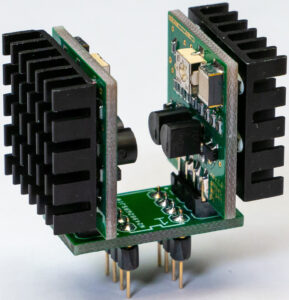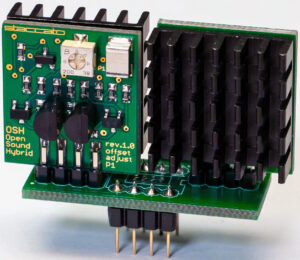A revelation and an exhortation
To what degree do the Staccato opamps change the sound? How can the prospective buyer know if it is worth the cost? The changes I am hearing with the swapping in of the Staccato opamps are on the order of a component change. The impact is in the same league as swapping an entire DAC or amp, and that is not exaggeration! Opamps must be one of the most despised internal parts by component makers. They confer such outstanding improvement — all of them do, really, but in this generation of products the Staccato is the most dramatic— that it is irritating to think the vast majority of the industry’s designers have eschewed them in favor of chip opamps due to cost, the goal of hitting a price target. Some are objectivist designers who have such confidence in their theory that they have never bothered to actually listen to discrete opamps in their products to discover that the numbers don’t tell everything about performance. The result is a “High Fidelity” industry that is churning out hindered solid-state electronics.
The situation is similar to the longstanding complaints of Magnepan speaker fans who lament the company’s use of “good enough” parts, even though the speakers would be fundamentally improved with better crossovers, wiring and posts. Do you need proof of that? Replace (your own risk, obviously) the horrid stock jumpers with nearly any fine speaker wire and hear for yourself the clear distinction with a change of jumpers. Magnepan customers want affordable speakers and they’re getting them, along with the implications of that affordability. When you hear an owner of stock Magnepan speakers boasting that they are the ultimate in an absolute sense, you know they are unaware of speaker design and build considerations.
Similarly, customers are not getting terribly close to the sonic potential of any component that relies upon chip opamps, unless the design avoids them altogether, and there are some designers and products that do so. But for the vast majority of products, opamps are a bread-and-butter internal part, so the problem of the opamps killing the sound quality is widespread. The odds are very strong that at least one or two of your components have cheap, mass-produced opamps. It is one of the travesties of the industry that manufacturers have been so slow to move to builds with discrete opamps.
To be fair, audiophiles who disdain price hikes due to lack of appreciation of such devices puts the screws to manufacturers because the makers do not want to eat the cost increase from putting discrete opamps into their components only to learn that their customers are too tight to pay for them, expecting the parts quality price increase to be absorbed by the maker. As I informally consulted Scott Kindt, the clever designer and maker of Aspen Acoustics Speakers (I reviewed the Lagrange L5 MkII, own the Lagrange L1 prototype, and will review the L1 production model), a couple of times he commented on upgrading a capacitor or a driver and said he would keep the price the same. I told him not to; yes, that is correct, I told him to increase the price of the speaker as well. Why? Because if a manufacturer keeps absorbing the increases, he will price himself out of business! I have no interest in exceptional audio makers dying on the vine because they ran their margins so thin that they extinguished their own company! The man is making a speaker that in my opinion already is too low in MSRP, and if he keeps up with the slashing of his own profit, there won’t be an Aspen Acoustics longer term.
You think I’m not on your side, customer? A few months ago, I had a conversation with Jim Salk, who makes high value-to-performance speakers. He cuts the profit to the bone, but he knows how to survive in the industry. He rattled off several bright people who started speaker companies that didn’t survive because they charged too little for their product. Result? Those companies went away and the community had less choice, fewer options to own an outstanding transducer at a reasonable price. My thrust here is not speakers, but components that will need to cost more to put discrete opamps in them. Please, dear readers, when a manufacturer points out that the cost is higher due to the presence of discrete opamps, kindly say, “That’s great,” rather than, “Well, I don’t think it makes that much difference,” that is, if you want to support manufacturers so that you will have choices of truly exceptional gear! Please trust that I do not say these things because I wish to pump up any given discrete opamp maker’s sales. I wish to have the community and myself enjoy truly premium products due to build, and that could happen across the industry if hobbyists demand it and support it with their purchases.
The entire community needs to grow up in regards to opamps. It is time to stop pretending that premium gear is being built and purchased when it is not. Understanding that this is only one consideration of a component’s design, have I made myself clear regarding how important the opamps are to the sound of the component? I suspect so, and I hope that many component makers will see this article and decide to highlight use of discrete opamps versus taking the easy route of tacking in insipid chip opamps.
Discussing it from the vantage point of the rank-and-file audiophile, the advantage of using discrete opamps is so powerful that I suspect some upper end designers are relying upon them heavily to gain sonic advantage and are inflating component prices. The component may not actually worth several thousands more, but may sound like it simply because discrete opamps were used. This article is not an investigation into industry practices, but I think it would make for a good report to see how many uber-equipment makers use discrete opamps versus run of the mill. There is certainly a wide performance difference between the stock sound of the aforementioned DAC and integrated amp versus when enhanced with the Staccato opamps. If a person did not know what was happening under the hood (car jargon), these companies could sell the “premium” version that simply had upgraded opamps for thousands more and the owner would be none the wiser. Do such things happen in the industry? I suspect so; caveat emptor is still in force. This article shows a clean way to juice a component with socketed opamps by use of discrete opamps, which is inexpensive relative to the standard expectations of improved sound. Completely ignore those who stomp their feet and point to measurements insisting there can be no difference sonically between cheap chip opamps and ones like the Staccato opamps; their methods result in mediocre audio systems.
- ← Previous page
- (Page 2 of 3)
- Next page →



Hi Doug
what would be the main sonic difference between these Staccato Kinki configuration and your previous Sonic Imagery Sparcos Labs Burson Kinki which I also have :)and now thinking of buying an extra Kinki EX-M1+
Anjo,
God’s Peace,
The Staccato opamps are the most dynamic and resolving, without being strident.
Blessings,
Douglas Schroeder
Hello Dough WOW that’s great to hear, besides the ex m1+ i’m also thinking of the ex p27 for what I know its full discrete although someone claims it has the socket for op-amps but i’m not sure maybe you have the answer.
best regards Anjo
Hello Doug,
Very interesting indeed! I am considering the EX M1+ and am wondering whether I would need risers in order to implement the Staccato op amps? Also in your experience which op amps are best placed and where within the amp?
Many thanks
David
David,
God’s Peace,
The risers are cheap and I keep about a dozen of them on hand for complete flexibility. The opamp maker may include some for you if you request. The best overall are the Staccato opamps throughout. But, opinions may vary depending upon other systems and preferences of sonic attributes. All these opamps are so cheap relatively speaking that I have them all and use them liberally. It is among the most economical system tuning methods I know.
Blessings,
Douglas Schroeder
Anjo,
God’s Joy,
I have not used the EX P27 and do not wish to speculate. I imagine that if you do a search for the component and “roll opamps” you will find plenty of discussion and confirmation if it does accept them.
Blessings,
Douglas Schroeder
Hey Doug, which model Duel opamp fit the min max dac. Thanks!
Dear Doug,
I was so excited to try the staccato op amps with my new Kinki EX-M1+. So ordered the op amps from Jakub. When they arrived I got to work. Opened up the amp and guess what they won’t fit without at least two risers on each op amp!!!!!!! In addition you need specific tools to extract the op amps off the circuit boards. I realize that inserting the Staccato op amps makes a HUGE difference BUT it is not an easy swap. Please let people know that it takes a”little skill” to do what you suggest. And you need special tools for op amp extraction and a magnifying glass to help with the op amp insertion. Somehow I was ignorant and believed that it was the same as changing tubes. IT is not!!!